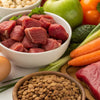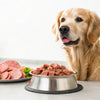Should Raw Dog Food Be Served Cold? Exploring the Best Temperatures for Your Furry Friend's Meals
- Houndsy
Table of Contents
- Introduction
- Understanding Raw Dog Food and Its Benefits
- The Temperature Conundrum: Cold or Warm?
- Best Practices for Serving Raw Dog Food
- Pet Parents' Experiences with Warming Raw Meals
- Hygiene Considerations in Serving Raw Dog Food
- The Houndsy Difference: Elevating Mealtime Rituals
- Conclusion
Introduction
Picture this: it's mealtime for our beloved canine companions, and we eagerly place their bowls on the ground, filled with the freshest raw ingredients. But here’s a question many dog parents wrestle with: should raw dog food be served cold straight from the fridge, or is warming it a better option? This dilemma is surprisingly common among pet owners navigating the transition to a raw diet.
Research shows that the temperature at which we serve food can significantly influence our dogs' dining experiences and, ultimately, their health and happiness. According to recent studies, pet parents who warm their dogs' meals notice increased interest and engagement during mealtime, which begs the question: is a warm meal truly more beneficial? In this blog post, we will delve into this topic, exploring the best practices for serving raw dog food and the potential effects on our furry friends.
By the end of this exploration, you’ll gain insights into serving temperatures for raw dog food, understand the impact of cold versus warm meals, and learn practical strategies to enhance your dog’s feeding experience. We’ll also touch upon the importance of proper handling and preparation, helping you elevate your pet’s mealtime ritual. So grab a cozy spot with your pup, and let’s dive into the art of serving raw dog food!
Understanding Raw Dog Food and Its Benefits
What Is Raw Dog Food?
Raw dog food is an increasingly popular dietary choice among pet owners aiming to provide their dogs with a nutrient-rich and natural meal. It typically consists of uncooked meats, organs, bones, fruits, and vegetables, offering a holistic approach to pet nutrition.
Health Benefits of Raw Feeding
The benefits of raw feeding include stronger immune systems, healthier coats, improved digestion, and increased energy levels. Dogs that eat raw diets often display fewer allergies and experience improved dental health due to the natural abrasive nature of raw bones. However, transitioning to a raw diet isn't merely about changing the food itself; it's also about adopting best practices regarding preparation and presentation.
The Temperature Conundrum: Cold or Warm?
Why Consider Serving Temperature?
Serving temperature directly affects a dog’s willingness to eat and can impact their digestive health. For many pets, cold food straight from the refrigerator can be unappealing and lead to certain gastrointestinal discomforts. A study published in the Journal of Animal Nutrition indicates that warm food may enhance nutrient absorption by further aiding the digestive process.
The Case Against Cold Raw Dog Food
-
Digestive Discomfort: Feeding dogs raw food that is too cold may lead to digestive issues. Dogs' digestive systems are typically accustomed to food at or near body temperature. When food is served cold, it may cause the stomach to work harder to reach the optimal digestion temperature, potentially resulting in nausea or bloating.
-
Affect on Appetite: Cold food may deter dogs from eating enthusiastically. Dogs rely heavily on their sense of smell, which is more pronounced when food is warmed. When temperatures are lower, the scent may not be as enticing, leaving our pups less interested in their meals.
-
Cultural Instincts: In nature, a dog's ancestors did not dine on cold prey. Warming food can simulate a more natural experience, aligning with our pets’ inherent instincts.
Best Practices for Serving Raw Dog Food
The Importance of Thawing
When serving raw dog food, proper thawing methods are critical. Here’s how to ensure that your dog’s meal reaches the right temperature:
-
Overnight Thawing: Place raw food in the fridge the night before serving. This gradual thawing keeps the meat at a safe temperature while preventing bacterial growth.
-
Room Temperature Thawing: If you’re short on time, you can let the food sit at room temperature for about 15-30 minutes before serving, ensuring it’s not ice-cold when served.
Warming Techniques for Raw Dog Food
If you're leaning toward warming your dog’s meal, there are various safe methods:
-
Counter Thawing: Remove the food from the fridge a few hours before feeding and let it warm on the counter. This will bring the food closer to room temperature safely.
-
Use of Bone Broth: A delicious alternative is to pour lukewarm bone broth over the meal. Not only does this warm the food, but it also adds flavor and nutrients.
-
Warm Water: Pour a small amount of warm (not boiling) water over the food right before serving. This technique also helps release enticing aromas, making the meal more appealing.
Avoiding the Microwave
While it may be tempting to quickly heat raw food in the microwave, this method is generally discouraged. Microwaves can heat food unevenly, which may lead to areas being too hot while others remain cold. Additionally, heating food to high temperatures can compromise its nutritional value and change the structural integrity of certain ingredients.
Pet Parents' Experiences with Warming Raw Meals
Many pet owners report positive changes when warming their dogs' meals. For instance, dogs that were previously picky eaters displayed renewed enthusiasm for their meals once their food was warmed. They were observed licking their bowls clean and eagerly anticipating mealtimes.
Conversely, owners sharing stories about cold raw food often noted decreased appetite or refusal to eat entirely. Some dogs experienced gastrointestinal issues, responding better to meals that were slightly warmed. The qualitative difference in feeding experiences highlights the importance of opting for warmth over chill.
Hygiene Considerations in Serving Raw Dog Food
One critical aspect of serving raw dog food is the hygiene protocol involved to ensure safety for both dogs and humans. Here’s how we can safeguard the feeding process:
-
Sanitize Surroundings: Always clean surfaces that have come into contact with raw food, including countertops, cutting boards, and utensils. Use hot, soapy water and appropriate disinfectants.
-
Handle with Care: Wash your hands thoroughly after handling raw food. Consider keeping separate utensils and bowls just for your pet to minimize the risk of contamination.
-
Monitor Time: If food isn’t consumed promptly, it’s vital to discard any leftovers after 15-30 minutes to reduce the risk of bacterial growth.
The Houndsy Difference: Elevating Mealtime Rituals
At Houndsy, we recognize that the feeding experience extends beyond the food itself. Our flagship product, the Houndsy Kibble Dispenser, designed with mid-century modern aesthetics, combines functionality and beauty to elevate your dog's mealtime ritual.
Key features include:
-
Convenient Crank Mechanism: The standing-height crank eliminates the need for bending, making your feeding routine easier and more enjoyable.
-
Perfect Portion Control: With our smart system, you can dispense exactly the right amount of kibble, ensuring delicious consistency every time.
-
Large Storage Capacity: Our dispenser holds 25–30 lbs of your dog's favorite food, minimizing the frequency of refills and maintaining a neat appearance in your home.
-
Safe Materials: Our BPA-free liner helps preserve the freshness of your pet's food and keeps their meals free of harmful chemicals.
When you consider how to serve raw dog food, think about how these factors can enhance the overall experience. By integrating quality feeding tools, such as the Houndsy Kibble Dispenser, we can simplify and beautify the daily ritual of pet care.
Explore the Houndsy Kibble Dispenser today and see how it can transform mealtime for you and your furry friend! Order Now.
Conclusion
In wrapping up our exploration into serving temperatures for raw dog food, we’ve uncovered not only the potential drawbacks of cold meals but also effective strategies for warming dog food to enhance palatability and digestive health.
From warming food to prioritizing hygiene, our dog feeding practices can profoundly impact our furry companions’ overall health and happiness. As we integrate thoughtful routines and quality tools into our feeding rituals, we honor our pets' needs and preferences while nurturing the precious bond we share.
Reflecting on these insights, consider the following: How does your dog respond to their meals currently? Could warming their food lead to a more enthusiastic mealtime? By continuously refining our practices, we can ensure mealtime remains a joyful and nourishing experience for our beloved pets.
FAQ
Q: Should I always warm my dog's raw food?
A: While it’s not mandatory, many dogs prefer their meals at room temperature or slightly warm. It can enhance their appetite and aid digestion.
Q: Can I serve frozen raw dog food?
A: It's advisable to fully thaw raw dog food before serving. However, some dogs do enjoy cold treats on occasion.
Q: What are the best warming methods for raw dog food?
A: Counter thawing, using warm bone broth, or pouring warm water are effective methods to warm raw dog food safely.
Q: How should I store raw dog food?
A: Store raw dog food in airtight containers in the fridge or freezer. Always thaw in the refrigerator when possible and avoid refreezing thawed food.
Q: Is it safe to microwave raw dog food?
A: Microwaving raw dog food is generally not recommended as it can unevenly heat the food and alter its nutritional value.
For pet parents keen to ensure the best feeding practices for their dogs, consider exploring the benefits of using the Houndsy Kibble Dispenser for a seamless feeding experience! Order Now.













